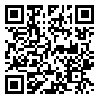Volume 18, Issue 4 (1-2020)
jhosp 2020, 18(4): 31-40 |
Back to browse issues page
Download citation:
BibTeX | RIS | EndNote | Medlars | ProCite | Reference Manager | RefWorks
Send citation to:



BibTeX | RIS | EndNote | Medlars | ProCite | Reference Manager | RefWorks
Send citation to:
Fathi M, Hariri T, MarkaziMoghaddam N. Recognition and analysis of medical errors in the intensive care unit in a public hospital in Tehran by GTT (Global Trigger Tool) in 2019.. jhosp 2020; 18 (4) :31-40
URL: http://jhosp.tums.ac.ir/article-1-6231-en.html
URL: http://jhosp.tums.ac.ir/article-1-6231-en.html
1- Associated Professor of Critical Care, Critical Care Quality Improvement Research Center at Shahid Modarres Hospital, Department of Anesthesiology, Shahid Beheshti University of Medical Sciences, Tehran, Iran.
2- MSc of Health Services Management, Researcher of Critical Care Quality Improvement Research Center Shahid Beheshti University of Medical Sciences Tehran, Iran.
3- Assistant Professor of department of Health Management and Economic, School of Medical, Aja University of Medical Sciences, Tehran, Iran. *Corresponding Author: nmmoghaddam@gmail.com / Assistant Professor and deputy of Critical Care Quality Improvement Research Center, Shahid Beheshti University of Medical Sciences, Tehran, Iran.
2- MSc of Health Services Management, Researcher of Critical Care Quality Improvement Research Center Shahid Beheshti University of Medical Sciences Tehran, Iran.
3- Assistant Professor of department of Health Management and Economic, School of Medical, Aja University of Medical Sciences, Tehran, Iran. *Corresponding Author: nmmoghaddam@gmail.com / Assistant Professor and deputy of Critical Care Quality Improvement Research Center, Shahid Beheshti University of Medical Sciences, Tehran, Iran.
Abstract: (5296 Views)
Background: Medical errors represent a serious problem for intensive care and increase the length of stay and mortality. Tracking of medical errors in hospital have focused on voluntary reporting of errors, but 10 to 20 % of errors are ever reported and, of those, 90-95 percent cause no harm to patients. This study was conducted to recognition and analysis medical errors in Intensive Care Unit by GTT in 2019.
Materials & Methods: This study was a retrospective descriptive-experimental and was conducted in the Intensive Care Unit of a public hospital in Tehran. In 2019 for 13 weeks,127 records were separately reviewed by two nurses by using the IHI checklist and final confirmation was performed by the physician. The data were analyzed by SPSS 22 software.
Results. 622 triggers, 277 adverse events related to triggers, 121 adverse events without trigger and totally 398 adverse events were identified in ICU. 93 records from 127 records had adverse events. The incidence rate of adverse events was 73/2%, 3/13 adverse events per patient and the incidence rate was 24/8 adverse events per 100 patients-day. The most frequency of events and harms were respectively related to care, intensive care, surgery and medication modules.
Conclusion. According to the result of patient records reviewing and the high rate of AEs that required intervention and also the result of similar study, we can state this tool is more reliable than other methods to detect AEs, such as voluntary reporting of error.
Materials & Methods: This study was a retrospective descriptive-experimental and was conducted in the Intensive Care Unit of a public hospital in Tehran. In 2019 for 13 weeks,127 records were separately reviewed by two nurses by using the IHI checklist and final confirmation was performed by the physician. The data were analyzed by SPSS 22 software.
Results. 622 triggers, 277 adverse events related to triggers, 121 adverse events without trigger and totally 398 adverse events were identified in ICU. 93 records from 127 records had adverse events. The incidence rate of adverse events was 73/2%, 3/13 adverse events per patient and the incidence rate was 24/8 adverse events per 100 patients-day. The most frequency of events and harms were respectively related to care, intensive care, surgery and medication modules.
Conclusion. According to the result of patient records reviewing and the high rate of AEs that required intervention and also the result of similar study, we can state this tool is more reliable than other methods to detect AEs, such as voluntary reporting of error.
Type of Study: Case Study |
Subject:
کیفیت خدمات و ایمنی بیمار در بیمارستان
Received: 2019/12/8 | Accepted: 2020/01/7 | Published: 2020/01/25
Received: 2019/12/8 | Accepted: 2020/01/7 | Published: 2020/01/25
| Rights and permissions | |
 |
This work is licensed under a Creative Commons Attribution-NonCommercial 4.0 International License. |





